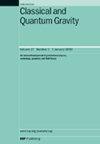The SXS collaboration’s third catalog of binary black hole simulations
IF 3.7
3区 物理与天体物理
Q2 ASTRONOMY & ASTROPHYSICS
引用次数: 0
Abstract
We present a major update to the Simulating eXtreme Spacetimes (SXSs) Collaboration’s catalog of binary black hole (BBH) simulations. Using highly efficient spectral methods implemented in the Spectral Einstein Code (SpEC), we have nearly doubled the total number of binary configurations from 2018 to 3756. The catalog now more densely covers the parameter space with precessing simulations up to mass ratio q = 8 and dimensionless spins up to with near-zero eccentricity. The catalog also includes some simulations at higher mass ratios with moderate spin and more than 250 eccentric simulations. We have also deprecated and rerun some simulations from our previous catalog (e.g. simulations run with a much older version of SpEC or that had anomalously high errors in the waveform). The median waveform difference (which is similar to the mismatch) between resolutions over the simulations in the catalog is . The simulations have a median of 22 orbits, while the longest simulation has 148 orbits. We have corrected each waveform in the catalog to be in the binary’s center-of-mass frame and exhibit gravitational-wave memory. We estimate the total CPU cost of all simulations in the catalog to be 480 000 000 core-hours. We find that using spectral methods for BBH simulations is over 1000 times more efficient than previously published finite-difference simulations. The full catalog is publicly available through the sxs Python package and at https://data.black-holes.org .SXS合作的第三个双黑洞模拟目录
我们对模拟极端时空(sxs)协作的双黑洞(BBH)模拟目录进行了重大更新。使用光谱爱因斯坦代码(SpEC)中实现的高效光谱方法,我们将二进制配置的总数从2018年增加了近一倍,达到3756个。目录现在更密集地覆盖了参数空间,处理模拟达到质量比q = 8,无因次自旋接近于零偏心。该目录还包括一些中等旋转的高质量比的模拟和250多个偏心模拟。我们还弃用并重新运行了以前目录中的一些模拟(例如,使用旧版本的SpEC或在波形中具有异常高误差的模拟)。在目录中模拟的分辨率之间的中位数波形差(类似于不匹配)是。模拟的中位数为22个轨道,而最长的模拟有148个轨道。我们已经修正了星表中的每个波形,使其符合双星的质心框架,并展示了引力波记忆。我们估计目录中所有模拟的总CPU成本为4800 000 000核小时。我们发现使用谱方法进行BBH模拟比以前发表的有限差分模拟效率高1000倍以上。完整的目录可以通过sxs Python包和https://data.black-holes.org公开获得。
本文章由计算机程序翻译,如有差异,请以英文原文为准。
求助全文
约1分钟内获得全文
求助全文
来源期刊

Classical and Quantum Gravity
物理-天文与天体物理
CiteScore
7.00
自引率
8.60%
发文量
301
审稿时长
2-4 weeks
期刊介绍:
Classical and Quantum Gravity is an established journal for physicists, mathematicians and cosmologists in the fields of gravitation and the theory of spacetime. The journal is now the acknowledged world leader in classical relativity and all areas of quantum gravity.
 求助内容:
求助内容: 应助结果提醒方式:
应助结果提醒方式:


